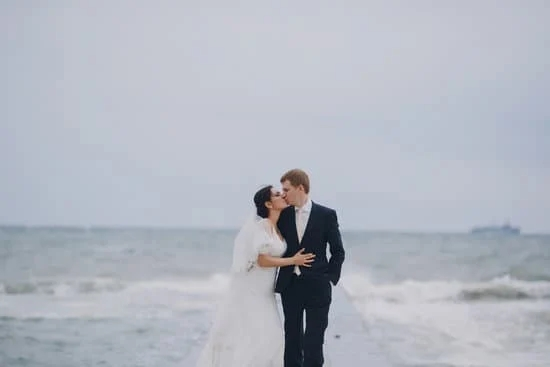A Catholic wedding is a sacred celebration that brings together two individuals in a union of love and faith. Rooted in the teachings of the Catholic Church, this special ceremony symbolizes the commitment and unity between a man and a woman. The sacrament of matrimony holds great significance within the Catholic faith, serving as a reflection of God’s love for His people.
In this article, we will delve into the spiritual foundations of a Catholic wedding, explore the required steps for preparation, uncover the sacred rites and traditions involved in the ceremony, and discuss various aspects such as music, attire, decorations, and more. Join us as we embark on an insightful journey through the beautiful world of Catholic weddings.
At its core, a Catholic wedding is not simply a legal contract or an expression of romantic love. It is much more than that – it is an outward manifestation of deep faith and religious commitment.
The sacrament of matrimony within the Catholic Church signifies the joining together of two souls under God’s watchful eyes. It reflects the belief that marriage is not just about companionship or mutual affection but also about embodying God’s love in partnership with another person.
To prepare for a Catholic wedding, couples are required to fulfill certain steps and undergo pre-Cana instructions. These preparations not only ensure that both individuals comprehend their responsibilities within marriage but also provide them with guidance on how to strengthen their relationship based on Christian values. Additionally, they allow couples to explore topics such as communication, conflict resolution, family planning, spirituality, and more.
In the following sections of this article, we will dive deeper into the various aspects that make up a traditional Catholic wedding ceremony – from symbolic rituals like exchanging vows and lighting a unity candle to incorporating Eucharist during Nuptial Mass. We will also examine traditional hymns and prayers that elevate the spiritual atmosphere during these sacred moments.
Furthermore, we will discuss catholic wedding attire requirements and customary bridal and groom’s attires, as well as explore the significance of decorations in enhancing the sacred space with symbols and floral arrangements.
Stay tuned for an in-depth exploration of the beauty and sanctity encapsulated within a Catholic wedding.
The Significance of the Catholic Sacrament of Matrimony
The Catholic Sacrament of Matrimony holds deep spiritual significance within the context of a Catholic wedding. Understanding the spiritual foundations of this sacrament allows couples to approach their marriage with a profound sense of purpose and commitment.
In Catholicism, matrimony is considered one of the seven sacraments, which are visible signs of God’s grace at work in our lives. The sacrament of matrimony signifies the union between Christ and his Church, mirroring the love and self-giving displayed by Jesus on the cross. This understanding highlights marriage as a sacred covenant between a man and a woman, rooted in love and fidelity.
The spiritual significance of the sacrament also extends to its lifelong nature. In Catholic teaching, marriage is indissoluble, meaning that it cannot be dissolved except through death. This understanding underscores the commitment and permanence required in married life, inviting couples to grow together throughout their journey while relying on God’s grace for support.
Couples preparing for a Catholic wedding are encouraged to delve deeper into their faith and relationship with God. They are called to attend pre-marital preparations, such as Pre-Cana instructions or Engaged Encounter retreats. These programs focus on fostering open communication, developing healthy conflict resolution skills, understanding the theology of marriage, and exploring topics related to family life.
To truly embrace the spiritual foundations of a Catholic wedding, couples may consider participating in other practices like frequent reception of the sacraments (such as Confession and Holy Communion) or engaging in regular prayer together. These practices can help deepen their relationship with God individually and as a couple.
Significance Table
| Aspect | Significance |
|---|---|
| Sacramental Nature | The sacrament signifies union between Christ and his Church, emphasizing love and self-giving |
| Indissolubility | The lifelong nature of marriage reflects commitment and permanence, requiring reliance on God’s grace |
| Preparation | Pre-marital programs help couples deepen their faith and develop skills for a healthy and fulfilling marriage |
| Spiritual Practices | Engaging in regular reception of sacraments and joint prayer can strengthen the couple’s relationship with God |
Preparing for a Catholic Wedding
Planning a wedding can be an exciting and joyful time in a couple’s life. However, when it comes to a Catholic wedding, there are specific steps and requirements that need to be fulfilled before the ceremony can take place. This section will explore the necessary preparations and pre-Cana instructions for couples planning a Catholic wedding.
One of the first steps in preparing for a Catholic wedding is to meet with the parish priest or deacon in charge of marriage preparation. They will guide the couple through the process and ensure that they meet all the requirements. Generally, couples are required to take part in a pre-Cana program, which is specifically designed to provide them with spiritual guidance, education on marriage values, and tools for building a strong foundation for their future together.
The pre-Cana instructions vary from one diocese to another but usually include attending retreats or workshops on topics such as communication, conflict resolution, and natural family planning. The purpose of these instructions is to help couples better understand their commitment to each other within the sacrament of matrimony and strengthen their relationship with God.
By participating in these programs, couples can gain valuable insights that will not only benefit them during their engagement but also carry over into their married life.
In addition to pre-Cana instructions, couples must fulfill other requirements such as attending marriage formation classes, obtaining any required paperwork (such as baptismal certificates), completing a prenuptial investigation (an interview conducted by the priest), meeting any diocesan guidelines regarding weddings held outside of parish churches, and participating in the rehearsal before the wedding day.
It is essential for couples to begin these preparations well in advance of their desired wedding date since fulfilling all these requirements may take some time.
The Catholic Wedding Ceremony
The Catholic wedding ceremony is a deeply meaningful and sacred event that follows a set of traditional rites and rituals. These rituals are rooted in centuries of religious tradition and serve to symbolize the couple’s commitment to each other, as well as their faith in God. Understanding these sacred rites can help couples fully appreciate the significance of their Catholic wedding ceremony.
One of the key elements of a Catholic wedding ceremony is the exchange of vows. This exchange is not merely a formality, but a solemn promise made by the couple to love and honor each other for the rest of their lives. The vows are typically recited in front of a priest or deacon, who acts as an official witness to the sacrament.
Another important element of the Catholic wedding ceremony is the blessing and exchange of rings. The rings symbolize the eternal love and fidelity between husband and wife. During this ritual, the priest blesses the rings before they are placed on each other’s fingers, signifying the couple’s commitment to one another.
In addition to these rituals, there may also be other customs that can be incorporated into a Catholic wedding ceremony. For example, some couples choose to include a unity candle ceremony, where two individual candles are lit by the bride and groom to symbolize their separate lives coming together as one.
Overall, it is important for couples planning a Catholic wedding ceremony to familiarize themselves with these sacred rites and traditions. By understanding their significance, couples can fully appreciate the beauty and depth of meaning behind each ritual. Additionally, consulting with their priest or deacon can provide further guidance on how to incorporate personal touches into their ceremony while still honoring these important traditions.
- Exchange of vows
- Blessing and exchange of rings
- Incorporating additional customs (such as unity candle ceremony)
Symbolism and Rituals in a Catholic Wedding
Symbolism and rituals play a significant role in Catholic weddings, as they add depth and meaning to the ceremony. From the lighting of the unity candle to the exchange of vows, each act carries religious symbolism that reflects the sacredness of the sacrament of matrimony.
The Unity Candle
One common ritual seen in Catholic weddings is the lighting of the unity candle. It typically takes place after the exchange of vows and rings. The unity candle symbolizes the merging of two lives into one and represents the couple’s commitment to each other.
The ritual involves two taper candles, typically held by family members or close friends, which are used to light a larger pillar candle. This act signifies the joining together of two families and serves as a reminder that love can bring warmth and light into their lives.
The Exchange of Vows
The exchange of vows is one of the most important moments in a Catholic wedding ceremony. It is during this moment that couples make their promises to love, honor, and cherish each other for as long as they live. These vows are considered sacred promises made before God, expressing their commitment to live out their marriage covenant in accordance with their faith. The words spoken by each partner carry deep meaning, reflecting their mutual love and devotion.
Blessing and Exchange of Rings
Another significant ritual in a Catholic wedding is the blessing and exchange of rings. Before exchanging rings, these symbols of love are usually blessed by a priest or deacon. This blessing acknowledges God’s presence in their union and asks for His guidance throughout their marriage journey. The rings themselves represent eternity, with no beginning or end, symbolizing the eternal love shared between spouses.
These various symbolic acts and rituals in a Catholic wedding serve as reminders not only to the couple but also to all who witness them; they signify an unconditional commitment between two individuals guided by faith and strengthened by their shared love.
Nuptial Mass
The celebration of the Nuptial Mass is a significant aspect of a Catholic wedding ceremony. It is during this part of the ceremony that the couple receives the Holy Eucharist, which holds great importance in the faith. The Nuptial Mass serves as a symbol of unity between the couple and God, and it strengthens their bond with each other and with their Catholic community.
Understanding the Sacrament of the Eucharist
In order to fully appreciate the significance of incorporating the Eucharist into a Catholic wedding ceremony, it is important to understand the Sacrament of the Eucharist itself. According to Catholic doctrine, during Communion, bread and wine are transformed into the body and blood of Jesus Christ. This transformation is believed to be a miraculous act performed by ordained priests, who have received holy orders.
The Role of the Eucharist in a Catholic Wedding Ceremony
During a Catholic wedding ceremony that includes Nuptial Mass, after exchanging their vows and rings, the couple proceeds to receive Holy Communion. This symbolizes their commitment not only to each other but also to living out their marriage according to God’s plan. By receiving the Eucharist together, they are inviting Jesus Christ into their married life and seeking His guidance and grace.
The reception of Holy Communion during a Nuptial Mass also signifies unity within the faith community present at the wedding. Family members, friends, and fellow Catholics will also have an opportunity to receive communion if they wish. This communal experience reinforces bonds among all those present, highlighting that marriage is not just an individual union but also one rooted in community support.
Traditional Catholic Wedding Music
Music plays a crucial role in Catholic weddings, as it enhances the spiritual atmosphere and elevates the entire ceremony. Traditional Catholic wedding music typically consists of hymns and prayers that carry a deep meaning and reflect the sacredness of the occasion. These carefully chosen songs create a beautiful backdrop for the couple’s union and help to guide worshippers’ hearts towards God.
During a Catholic wedding ceremony, there are specific moments where music is traditionally incorporated. These include the entrance procession, lighting of the unity candle, offertory, communion, and recessional. For the entrance procession, a joyful and vibrant hymn such as “Alleluia. Sing to Jesus” or “Praise to the Lord, the Almighty” can be sung. This sets a joyous tone as the bride walks down the aisle.
As for the lighting of the unity candle, a beautiful instrumental piece can be played to create an atmosphere of reverence and connectivity between the bride and groom. Frequently used selections include classical compositions like Pachelbel’s Canon in D or Handel’s Air from Water Music Suite. The offertory is another moment traditionally accompanied by music, usually focusing on themes of love, sacrifice, and commitment.
During communion is when one or more hymns are sung as worshippers receive the Eucharist. Some commonly selected hymns for this moment are “Ave Maria,” “Panis Angelicus,” or “Gift of Finest Wheat.” These spiritual songs encourage reflection on Christ’s sacrifice and express gratitude for His presence in their union.
Lastly, for the recessional, an uplifting hymn is sung as newlyweds make their way back down the aisle. Popular choices include Mendelssohn’s “Wedding March” or Handel’s “Hallelujah Chorus.” These triumphant pieces fill everyone with joy and send the couple off to their new life together with a sense of celebration.
In addition to the hymns, prayers are also an integral part of traditional Catholic wedding music. The Mass includes prayers such as the Responsorial Psalm, Gospel Acclamation, and the Lord’s Prayer. These prayers are often beautifully set to music and sung by a cantor or choir. The congregational responses during these prayers serve as a way for everyone present to participate and engage with the sacred ceremony.
Overall, traditional Catholic wedding music provides a divine backdrop for this sacred celebration of love and faith. From joyful processional hymns to reflective communion songs, each musical choice serves to elevate the spiritual atmosphere and guide worshippers’ hearts toward God. Through carefully selected hymns and prayers, couples can create a meaningful and memorable experience for themselves and their loved ones attending their wedding ceremony.
Catholic Wedding Attire
One of the important aspects of a Catholic wedding is the attire worn by the bride, groom, and members of the bridal party. The dress code for a Catholic wedding ceremony is usually more formal and conservative compared to other types of weddings. It is essential to understand the dress code guidelines and customary attire in order to respect the sacredness of the occasion.
For the bride, a traditional Catholic wedding dress typically features long sleeves and a floor-length skirt. Modesty is highly valued in Catholicism, so brides are encouraged to choose dresses that cover their shoulders and do not reveal too much skin. Veils are also commonly worn by Catholic brides as a symbol of purity and modesty. Many brides opt for a cathedral-length veil which extends past the length of their train.
Grooms are expected to wear formal attire for a Catholic wedding, usually consisting of a black or dark-colored suit with a white shirt and tie. However, some grooms may choose to wear a tuxedo for an even more formal look. It is common for grooms to wear a boutonniere, traditionally made from white flowers like roses or carnations.
The bridal party’s attire should also adhere to the prescribed dress code. Bridesmaids typically wear matching dresses that complement the style and color scheme chosen by the bride. These dresses are often modest with sleeves and appropriate lengths. Groomsmen usually follow the groom’s lead in terms of attire, wearing suits or tuxedos that match or coordinate with his outfit.
By following these customary guidelines for dressing at a Catholic wedding, couples can ensure that their attire respects traditions while still reflecting their personal style on this sacred occasion.
Catholic Wedding Decorations
In conclusion, the Catholic wedding ceremony is a deeply sacred and meaningful celebration of love and faith. Throughout the various sections of this article, we have delved into the spiritual foundations, required steps, sacred rites and traditions, symbolism and rituals, incorporation of the Eucharist, traditional music, attire, and decorations that are all elements of a Catholic wedding.
One important aspect to consider when planning a Catholic wedding is the decoration of the sacred space. Symbols and floral arrangements play a significant role in enhancing the spiritual atmosphere of the ceremony. The use of symbols such as crucifixes, statues of saints, and images of the Virgin Mary can help create an ambiance that honors the religious significance of marriage within the Catholic faith.
Floral arrangements can also add beauty and meaning to the sacred space. Choosing flowers with symbolic meanings such as roses for love or lilies for purity can infuse deeper significance into the overall aesthetic. Additionally, incorporating seasonal flowers or flowers that hold personal significance to the couple can further customize this aspect of the decor to reflect their unique journey together.
Ultimately, every element of a Catholic wedding – including decorations – should serve to uplift and enhance both the spiritual experience for those attending and the union being celebrated. Through careful consideration and adherence to tradition and symbolism, couples can create a truly awe-inspiring atmosphere that reflects their love for one another as well as their shared faith.
Frequently Asked Questions
What happens at a Catholic wedding?
A Catholic wedding is a sacred ceremony that takes place within the context of the Catholic Church. It is considered a sacrament, a visible sign of God’s graces present in the lives of the couple entering into marriage. During a Catholic wedding, several key rituals and prayers are performed. First, there is an opening hymn followed by an introductory rite and procession.
The liturgy of the Word then takes place, which includes readings from the Bible and a homily where the priest offers guidance and reflection on the Scriptures. The exchange of vows, rings, and consent occurs, symbolizing the couple’s commitment to one another and their intention to live out their marriage according to the teachings of the Catholic Church. A special blessing is given to seal their union, followed by prayers of intercession for various intentions. Finally, there is a closing prayer and recessional as all those in attendance celebrate the newly married couple.
What are the rules for Catholic marriage?
The rules for Catholic marriage stem from Canon Law and include various requirements that must be met for a valid sacramental marriage within the Catholic Church. Some key rules include that both parties must be free to marry (not currently bound by any previous marital bonds), they must freely consent to enter into marriage without any external coercion or force, and they must have an understanding of what they are entering into – a lifelong commitment to one another with openness to children.
Additionally, at least one party must be baptized in order for it to be recognized as sacramental by Catholics; otherwise, it may still be recognized as a natural but not sacramental marriage known as “marriage in disparity of cult.” Other specific requirements may vary depending on local diocesan guidelines or cultural traditions within certain regions.
What is the structure of a Catholic wedding?
The structure of a Catholic wedding typically follows a general order laid out in liturgical guidelines provided by the Church. It begins with an opening hymn and procession as everyone gathers together for worship. This is followed by the liturgy of the Word, where Scripture readings are proclaimed and a homily is given. After this, the liturgy of marriage takes place, which includes the exchange of vows and rings. The couple expresses their consent to marry in front of witnesses, typically in the presence of a priest or deacon who officiates the ceremony.
A special blessing may be bestowed upon them, symbolizing God’s grace and presence in their union. Prayers are offered for various intentions, both for the couple themselves and for the world at large. Finally, there is a closing prayer and dismissal before everyone comes together to celebrate with the newly married couple and offer congratulatory wishes. This general structure provides a framework within which Catholic weddings take place but can also allow for variations based on cultural customs or personal preferences while ensuring that essential elements remain present.

Welcome to my blog about home and family. This blog is a place where I will share my thoughts, ideas, and experiences related to these important topics. I am a stay-at-home mom with two young children. I hope you enjoy reading it! and may find some helpful tips and ideas that will make your home and family life even better!





